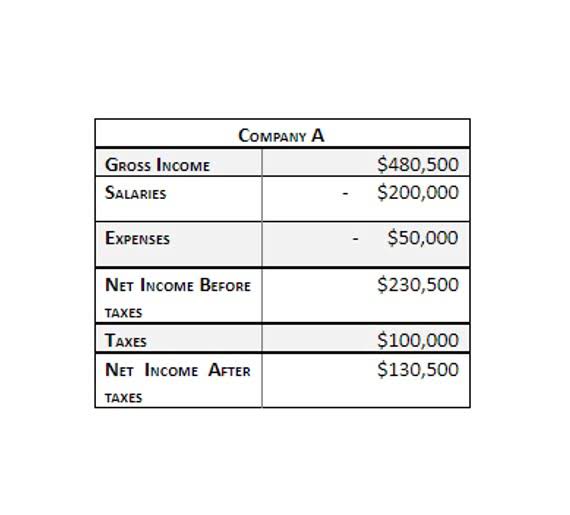
The work in progress report provides a summary of the information used in the percentage of completion calculation. It includes the total revised contract amount, total costs to date, percent complete based on cost, amount billed to date, and the difference between the amount billed and the percent of revenue that can be recognized. The percentage of completion method must be used if the revenues and costs of a project can be reasonably estimated and the parties involved are expected to be able to complete all duties. Further, this method is vulnerable to fraud and underreporting of a milestone period, so accounting practices must be closely reviewed. The percentage of completion method allows for the recognition of revenues, expenses, and taxes during the period that a contract is being executed. Through frequent reporting, percentage reporting reduces the risk of fluctuations while affording tax deferral benefits.
- To clear the full contract amount from Progress Billings, they’ll perform a debit, then credit revenue.
- Corporations (other than S corporations) may deduct this amount as interest expense.
- Total revenue and total gross profit recorded under both the methods are same.
- Instead, file Form 8697 separately with the IRS at the applicable address listed below.
Because income recognition is based on a percent of the revised contract for each project, it’s important that contractors enter change orders into the system as soon as they are approved. Instead of costs, percentage of completion can also be calculated using units or labor hours, depending on the nature of the business. The important thing to remember is that contractors must be consistent in how they calculate the percent complete. The company will report its revenue of $1 million to recognize the two payments for $500,000 that the customer made at the end of the six-month and one-year milestones.
Interest Received Journal Entry
For contracts on the POC method, an additional deferral is available with the opportunity to elect the 10% method. Under this election, income and expenses are not recognized for tax purposes until the contract is over 10%. Accrual excluding retainage is similar to accrual; however, it has the advantage of not recognizing retainage until it is received. Retainage receivable is common in certain types for contractors, and this method helps to postpone paying tax on some income until the taxpayer receives the cash to pay the taxes. Under this method, retainage payable is also not recognized—so that should be considered when evaluating whether this method is appropriate. There is also a 10% rule, whereby, if the taxpayer so elects, the recognition of income and the deduction of expenses can be delayed until the tax year in which at least 10% of the cumulative, allocable contract costs have been incurred.
- Therefore, if the project is deemed to be 40% complete, the business would report 40% of the $4 million project revenue ($4 million x 0.4).
- Taxpayers reporting line 2 amounts from more than one Schedule K-1 (or a similar statement) must attach a schedule detailing by entity the net change to income from long-term contracts.
- The completed contract method defers all revenue and expense recognition until the contract is completed.
- The total contract price is $200,000 (the amount remaining to be paid under the terms of the contract less the consideration paid allocable to the contract ($1,000,000 − $650,000 − $150,000)).
- When using the completed contract method, it is important to plan and keep a focus on your backlog.
- For a construction contractor that means using the Percentage of Completion Method for their financial statements.
Additional interest to be refunded for periods after the filing date of Form 8697, if any, will be computed by the IRS and included in your refund. Report the amount on line 9 (or the amount refunded by the IRS if different) as interest income on your income tax return for the tax year in which it is received or accrued. An owner of an interest in a pass-through entity is not required to provide the detail listed in 1 and 2 above with respect to prior years. The entity should provide the line 2 amounts with Schedule K-1 or on a separate statement for its tax year in which the contracts are completed or adjusted.
How to Protect Your Payments When Dealing with a Construction Bankruptcy
Before project completion, this method usually has no useful information to the reader, especially on the financial statements. The completed contract method (CCM) is an accounting technique that allows companies to postpone the reporting of income and expenses until after a contract is completed. Using CCM accounting, revenue and expenses are not recognized on a company’s income statement even if cash payments were issued or received during the contract period. XYZ believes that if given the contract, they will be able to complete the project in 7 months’ time. Now, when ABC is dealing with a short-term project, it uses the completed contract method of revenue recognition. In the contract, the organization has given an offer of $5 million that is willing to pay ABC once they complete the project.
A contractor’s tax return can have more than one method of accounting at the same time. The method of accounting will depend on the types of contracts the contractor works on. For example, a contractor will be using the POC method for non-exempt long-term contracts, completed contract method on home construction contracts, and accrual less retainage on short-term contracts. While guidance for revenue recognition may have changed in recent years, contractors will find much from the completed contract method alive and well. If the gist is to hold off revenue from the income statement until it’s assured, ASC 606 point-in-time recognition uses a similar procedure. Where the completed contract method looks at contracts, however, ASC 606 looks at performance obligations.
Alternative Minimum Tax
It will still yield the same results as the commonly used percentage of completion method, except that revenue recognition comes at the end of the project. As of this time, C is claiming $14,000 in addition to the original contract price for certain changes in contract specifications which C alleges have increased his costs. In 2003, the disputes between C and B are resolved by performance of additional work by C at a cost of $1,000 and by an agreement that the contract price would be revised downward to $996,000. Under these circumstances, C must include in his gross income for 2002, $994,000 (the gross contract price less the amount reasonably in dispute because of B’s claim, or $1,000,000 − $6,000). In 2002, C must also take into account $1,000,000 of allocable contract costs (costs incurred less the amounts in dispute attributable to both B’s and C’s claims, or $1,020,000 − $6,000 − $14,000). In 2003, C must take into account an additional $2,000 of gross contract price ($996,000 − $994,000) and $21,000 of allocable contract costs ($1,021,000 − $1,000,000).
This can cause a significant fluctuation of expenses and revenue in the balance sheet. To those outside the company, this could be seen as a sign of inconsistency and risk, which can make securing bonding or acquiring financing particularly tricky. The completed-contract method can be used only by the home construction projects or other small projects. In contrast with percentage of completion, the completed contract method is used to recognize project revenue and costs only when the contract is complete.
When to use a Completed Contract Method
Over 1.8 million professionals use CFI to learn accounting, financial analysis, modeling and more. Start with a free account to explore 20+ always-free courses and hundreds of finance templates and cheat sheets. We may give this information to the Department of Justice for civil or criminal litigation, and to other federal agencies as authorized by law.

The most common is costs incurred to date, but they can also use units completed or labor hours. Construction in Process and Progress Billings will continue to accrue until the project wraps up. Once Build-It Construction completes the contract, they may finally move these onto the income statement. To clear the full contract amount from Progress Billings, they’ll perform a debit, then credit revenue. To recognize the costs of the contract, they’ll credit Construction in Progress and debit their expenses.
A long-term contract is defined as any contract for the manufacture, building, installation, or construction of real property if the contract is not completed within the tax year in which it is entered. A contract that extends beyond the tax year in which it is entered into is considered a long-term contract although the contract may last less than 12 months. Al’s Construction, Co. is building a five story building under a contract price of $700,000 and plans completed contract method formula to start construction on March 15, 2017; the commencement date of the contract. Al’s Construction, Co. expects that the entire facility will be completed by December 31, 2017. The term of the contract is less than one year and the contract will start and is expected to be completed within the same tax year . Al’s Construction, Co. meets the requirements and elects to use the Completed Contract Method of accounting for long-term contracts for tax purposes.

